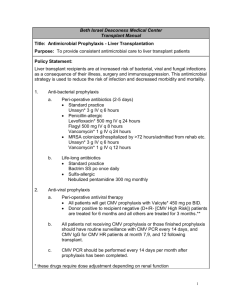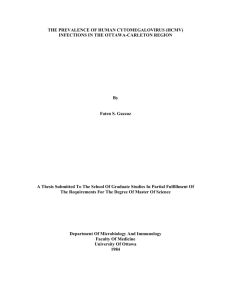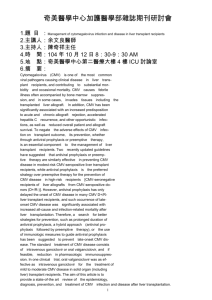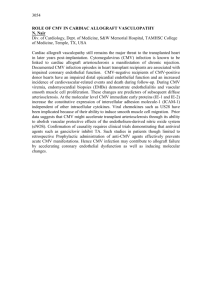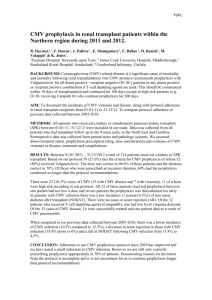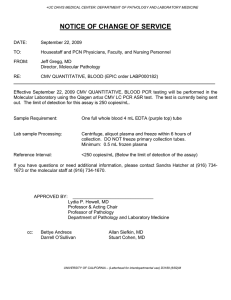Chapter 7
advertisement
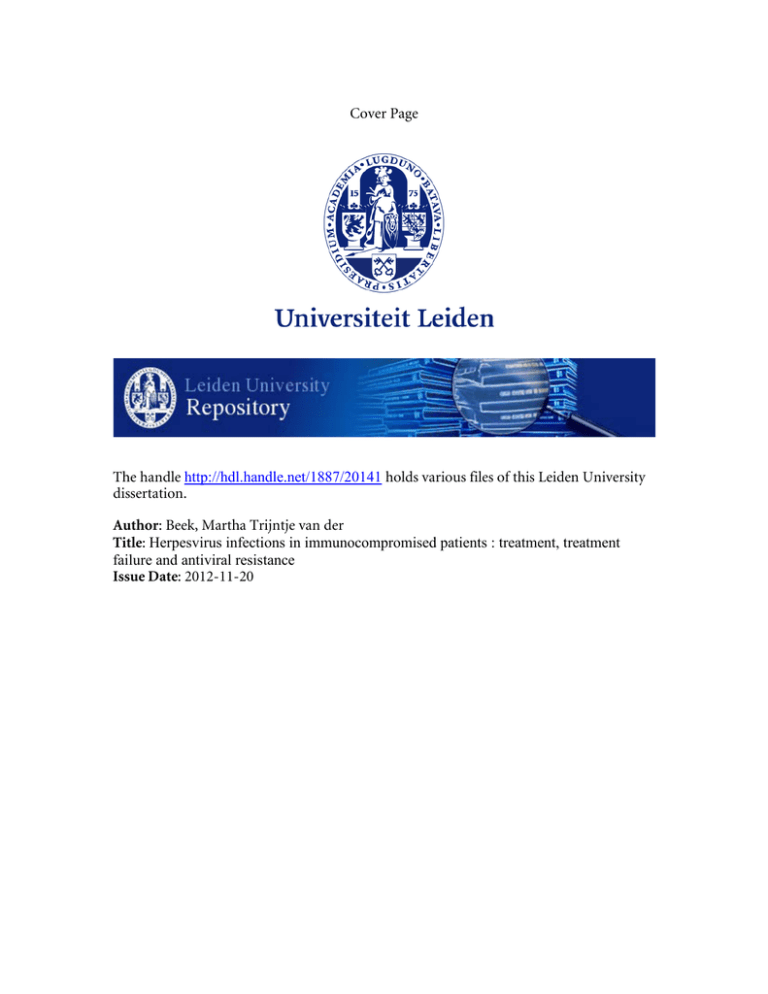
Cover Page The handle http://hdl.handle.net/1887/20141 holds various files of this Leiden University dissertation. Author: Beek, Martha Trijntje van der Title: Herpesvirus infections in immunocompromised patients : treatment, treatment failure and antiviral resistance Issue Date: 2012-11-20 7 Preemptive versus sequential prophylactic-preemptive treatment regimens for CMV in renal transplantation: comparison of treatment failure and antiviral resistance. Martha T. van der Beek1 Stefan P. Berger2 Ann C.T.M. Vossen1 Caroline S. van der Blij-de Brouwer1 Rogier R. Press3 Johan W. de Fijter2 Eric C.J. Claas1 Aloys C.M. Kroes1 1Department of Medical Microbiology, 2Department of Nephrology, 3Department of Clinical Pharmacy and Toxicology, Leiden University Medical Center, Leiden, The Netherlands Transplantation, 2010; 89:320-6 proefschrift.indd 105 8-10-2012 19:21:01 Chapter 7 Abstract Background: Cytomegalovirus (CMV) infections after transplantation are commonly treated using a prophylactic or preemptive regimen with (val)ganciclovir. It remains unclear which approach is most effective in preventing CMV disease in D+R- patients. The aim of this retrospective study was to compare treatment response and antiviral resistance in CMV infections between two treatment regimens in D+R- renal transplant recipients. Methods: Before 2006, a preemptive treatment regimen with valganciclovir was applied (42 patients). From 2006 onwards, patients first received prophylaxis with valganciclovir for 90 days, followed by a preemptive regimen (29 patients). CMV infections were monitored by regular determination of the CMV-DNA load in plasma. Patient charts were reviewed for antiviral treatment data and resistance was analyzed by nucleotide sequence analysis of the UL97 and UL54 genes in CMV-DNA positive samples. Results: Treatment failure, defined as a CMV DNA load ≥ 1000 copies/ml after at least 2 weeks of treatment, occurred less frequently in the prophylaxis cohort than in the preemptive cohort (14% versus 71%, p < 0.001). No CMV end-organ disease occurred in either cohort. Resistant viral isolates were found during treatment in one patient in the prophylaxis cohort versus in three patients in the preemptive group. All CMV infections with resistant virus were cleared without switch of (val)ganciclovir treatment. Conclusions: Treatment failure of CMV infections occurred less frequently in D+R- renal transplant patients on a sequential prophylaxis-preemptive regimen, than in patients on a purely preemptive regimen. Antiviral resistance was observed infrequently and apparently played a minor role in treatment failure. 106 proefschrift.indd 106 8-10-2012 19:21:01 CMV treatment failure and resistance after renal transplantation Introduction Prophylactic and preemptive regimens are widely applied in renal transplant recipients to reduce morbidity and mortality associated with cytomegalovirus (CMV) disease. Patients at high risk for CMV disease after transplantation are transplant recipients who are CMV-seronegative prior to transplantation and receive an organ from a CMV-seropositive donor (D+R-). Without preventive measures, CMV disease occurs in about 70% of D+R- patients.1;2 It remains unclear whether a prophylactic or a preemptive approach is most effec- tive in preventing CMV disease in D+R- patients.3 In a direct comparison of prophylaxis versus preemptive treatment in renal transplant recipients using valganciclovir (vGCV), prophylaxis reduced the incidence of CMV infection in all transplant recipients, except for D+R- patients.4 Furthermore, no reduction in symptomatic episodes was observed.4 In a trial using oral ganciclovir (GCV) for prophylaxis versus intravenous GCV for preemptive treatment, prophylaxis also reduced the incidence of CMV infection and increased long-term graft survival in all recipients5. No separate data were available for D+R- patients.5 After prophylaxis, late onset CMV disease still occurs in about 30% of D+R- transplant patients, necessitating follow up after prophylaxis.6-9 Treatment of CMV infections in D+R- patients does not always lead to a rapid and sustained viral response.4;10 Such treatment failure may be related to the type of treatment regimen, to immunological factors or it may be caused by viral resistance. Resistance of CMV to antiviral agents can occur after prolonged exposure to antiviral drugs,11 both in prophylactic and preemptive treatment regimens. Yet, it is unknown if either type of CMV treatment regimen predisposes to the development of antiviral resistance. Our hospital has recently chosen to change its strategy for the prevention of CMV disease in D+R- renal transplant recipients. The purely preemptive strategy has been replaced by a three-month prophylaxis regimen followed by preemptive treatment. In this retrospective study, we compared the incidence and course of CMV infections, the frequency of treatment failure of CMV infections and the role of antiviral resistance between the purely preemptive versus the prophylaxis followed by preemptive treatment regimen. Patients and Methods Patients Consecutive D+R- kidney and kidney-pancreas transplant recipients transplanted in the Leiden University Medical Center between 2004 and 2008 were included (n = 78). 107 proefschrift.indd 107 8-10-2012 19:21:01 Chapter 7 Table 1. Baseline characteristics of the included patients. preemptive prophylaxis n = 42 n = 29 n (% of patients ) n (% of patients ) regimen age at Tx gender age (years, mean) male 46 24 (57) 49 18 (62) n.s. n.s. underlying disease PKD 7 (17) 3 (10) n.s. diabetes mellitus 9 (21) 8 (28) hypertension 4 (10) 3 (10) other 22 (52) 15 (52) kidney 35 (83) 25 (86) kidney-pancreas 7 (17) 4 (14) living related 11 (26) 8 (28) living unrelated 6 (14) 7 (24) post mortal HB 12 (29) 10 (35) post mortal non-HB 13 (31) 4 (14) prednisone 42 (100) 29 (100) cyclosporine 32 (76) 27 (93) tacrolimus 10 (24) 2 (7) mycophenolate 42 (100) 29 (100) type of Tx type of donor immunosuppressive regimen directly after Tx n.s. n.s. n.s. n.s. Tx, transplantation; HB, heart beating; PKD, polycystic kidney disease; n.s., not significant (p >0.05). Follow-up was one year after transplantation. The initial immunosuppressive regimen consisted of prophylaxis with either antibodies against the IL-2 receptor alphachain (basiliximab/daclizumab) or anti-thymocyte globulin (ATG, Fresenius Kabi, Utrecht, The Netherlands) for kidney and kidney-pancreas transplant recipients, respectively. Maintenance immunosuppression consisted of three immunosuppressive drugs including prednisolone, either tacrolimus or cyclosporine and either mycophenolate mofetil or mycophenolic acid (see Table 1). Exposition to tacrolimus and cyclosporine was monitored by area-under-the-curve (AUC) measurements. First acute rejection episodes were treated with methylprednisolone and second rejection episodes were treated with ATG (Merieux, Genzyme, Naarden, The Netherlands). The immunosuppressive regimen, target AUC ranges and rejection treatment were unchanged throughout the study period. 108 proefschrift.indd 108 8-10-2012 19:21:01 CMV treatment failure and resistance after renal transplantation CMV treatment During the study period, the protocols for CMV prevention and treatment were changed from a purely preemptive strategy to initial prophylaxis followed by a preemptive regimen. In all regimens, (v)GCV dosing was adapted according to renal function (dose reduction if creatinin clearance was below 60 ml/min). Before 2006, a preemptive treatment regimen with valganciclovir (900 mg twice daily for 14 days) was applied which was guided by the CMV DNA load. Treatment was initiated at the first detectable CMV DNA load after transplantation. Subsequent DNAemia episodes were treated if the load was above 100.000 copies/ml or above 10.000 copies/ml and increasing at least tenfold in one week. From 2006 onwards, patients received prophylaxis with vGCV (900 mg once daily) for 90 days, followed by a preemptive regimen. CMV DNAemia occurring after prophylaxis was treated (900 mg twice daily for 10-14 days) if the load was above 100.000 copies/ml or above 10.000 copies/ml and increasing at least tenfold in one week. In both regimens, symptomatic CMV infection was treated with intravenous GCV (5 mg/kg twice daily for 14 days) and, if possible with regard to the risk of rejection, the use of mycophenolate mofetil or mycophenolic acid was reduced or temporarily discontinued. Data collection Patient and treatment data were collected retrospectively from patient charts. Baseline data that were registered included age, sex, underlying renal disease, type of donor and transplantation, CMV serostatus of donor and recipient prior to transplantation and immunosuppressive medication directly after transplantation. Follow-up data that were collected were immunosuppressive medication at onset of each CMV DNAemia episode, rejection treatment episodes, signs and symptoms of CMV end-organ disease,12 renal function at six and twelve months after transplantation, patient survival and graft survival. Start and end date, and dosage of antiviral medication were documented. Creatinin clearance based on 24-hour urine collection and creatinin serum levels was registered at start of antiviral medication and subsequently monthly during antiviral medication to check for adequate dosing of antiviral medication in relation to renal function. CMV monitoring CMV DNA loads in EDTA plasma had been determined prospectively by quantitative real-time PCR.13 CMV IgG (Vidas 30, Biomérieux, Zaltbommel, The Netherlands) was determined retrospectively in EDTA plasma samples. 109 proefschrift.indd 109 8-10-2012 19:21:01 Chapter 7 Antiviral resistance analysis Analysis of resistance was performed by nucleotide sequence analysis on CMV DNA from plasma samples. Cycle sequencing reactions were performed after PCR and nucleotide sequence analysis was performed on an ABI Prism 3100 Genetic Analyser (Applied Biosystems, Warrington, United Kingdom). For amplification and cycle sequencing forward primer GTGCTCACGGTCTGGATGT and reverse primer CGGTGGGTTTGTACCTTCTC were used. Additional cycle sequencing primers were forward primer GATTACAGCCTCAGCGAG and reverse primer CGTCTCCTGAAAGACGG. The detection limit of the assay was 1000 copies/ml of CMV DNA and the amplified region ranged from codon 370 to 708 of the UL97 gene, covering all previously described mutations.14;14 Sequences were compared to the sequence of the wild type AD169 strain and to pre-treatment samples from the patient. Baseline resistance was determined in the first sample from each patient contain- ing at least 1000 copies/ml of CMV DNA. Resistance during treatment was determined by analysis of subsequent plasma samples containing at least 1000 copies/ml of CMV DNA after at least two weeks treatment of CMV infection. Sequence analysis of codon 262 to 1169 of the UL54 gene was performed on DNA from samples from patients using foscarnet or cidofovir. End points The two treatment regimens were compared for timing, incidence and course of CMV DNAemia and the occurrence of treatment failure and resistance. The course of CMV DNAemia was expressed as the AUC of the CMV loads of each patient. The AUC is a reflection of the total exposure of the patient to CMV and was calculated using the trapezoidal model as previously described.15 Since quantification of low plasma loads in the range below 250 copies/ml is less precise, the AUC above this threshold was calculated. Treatment failure was defined as the presence of at least 1000 copies/ml of CMV DNA in plasma after at least two weeks of treatment of CMV infection. Resistance was defined as the presence of resistance-associated mutations in the UL97 or UL54 gene.14;14 Statistical analysis For statistical analysis of dichotomous variables the Pearson Chi-square test or Fisher’s exact test were used. Because for most continuous variables a normal distribution was not assumed, the Mann-Whitney-U-test was used. 110 proefschrift.indd 110 8-10-2012 19:21:01 CMV treatment failure and resistance after renal transplantation Results Patients Plasma samples and treatment data were available from 78 transplanted D+R- patients. Baseline characteristics of the patients from the two regimens are shown in Table 1. Of the 71 included patients, 42 had been treated according to a purely preemptive regimen and 29 primarily with prophylaxis. Seven patients were excluded from the analysis for the following reasons; two patients died within one month after transplantation, two patients received prolonged courses of cidofovir for BK-virus and three patients were treated with delayed prophylaxis after rejection treatment. No significant differences were present in baseline characteristics between the two treatment regimens. Viral Monitoring The number of plasma samples submitted for CMV DNA load determination during the first three months after transplantation was higher in the preemptive cohort than during prophylaxis (median of 10 versus 6 samples, p < 0.01), but was similar during the remainder of the year (median of 11 versus 10 samples, p 0.39). CMV DNAemia Timing of CMV DNAemia differed significantly between the two treatment regimens; the first CMV DNA load was detected after a median of 33 days after transplantation in the preemptive cohort and after 138 days in the prophylaxis cohort (p < 0.01, Figure 1). Breakthrough CMV DNAemia occurred in one patient in the prophylaxis cohort, who already had a CMV infection at the start of prophylaxis (Figure 1). The incidence of CMV DNAemia was similar in both cohorts; 29 patients (69%) in the preemptive cohort and 15 patients (52%) in the prophylaxis cohort had CMV DNAemia in the first year after transplantation (p 0.14, Figure 2). The percentage of patients reaching a CMV DNAemia of at least 1000 copies/ml was significantly higher in the preemptive cohort than in the prophylaxis cohort; 69% of the patients in the preemptive cohort versus 45% of the patients in the prophylaxis cohort (p 0.04, Figure 2). The threshold of 10.000 copies/ml was reached by 55% and 24% of patients in each cohort respectively (p 0.01, Figure 2). The course of CMV DNAemia was significantly different between the two regimens; the AUC above 250 copies/ml was significantly higher in the preemptive cohort than in the prophylaxis cohort (mean of 2.1∙106 versus 0.9∙106 copies∙day/ml, Mann-Whitney U-test p 0.03). In the patients with CMV DNAemia, the period in which CMV DNA was present after transplantation was longer in the preemptive cohort than in the prophylaxis cohort (median of 203 versus 79 days, p < 0.01). 111 proefschrift.indd 111 8-10-2012 19:21:02 Chapter 7 Figure 1. Time to first CMV DNAemia. The median time to first CMV DNAemia was 33 versus 138 days in the preemptive versus the prophylaxis cohort (p < 0.01). Figure2.2 Incidence Figure IncidenceofofCMV CMVDNAemia. DNAemia. 80 70 preemptive (n = 42) n.s. P < 0.05 69 69 P < 0.05 % of patients 60 50 prophylaxis (n = 29) 55 52 45 40 30 24 20 10 0 DNAemia positive DNAemia ≥ 10log3 DNAemia ≥ 10log4 The percentage of patients having DNAemia, reaching 1000 copies/ml CMV DNA in plasma and reaching 10.000 copies/ml CMV in plasma in the firsthaving year after transplantation. n.s.,1000 not significant. The DNA percentage of patients DNAemia, reaching copies/ml CMV DNA in plasma and reaching 10.000 copies/ml CMV DNA in plasma in the first year after transplantation. n.s., not significant. 112 proefschrift.indd 112 8-10-2012 19:21:02 CMV treatment failure and resistance after renal transplantation No CMV end-organ-disease occurred in the study cohort. One patient died and one graft was lost, but both events were unrelated to CMV infection. Seroconversion for CMV IgG occurred in the first three months after transplantation in 57% of the patients in the preemptive cohort and in 3% of the patients in the prophylaxis cohort (p <0.01). The two treatment regimens did not show a significant difference in the number of rejection episodes or the renal function at six and twelve months after transplantation. Rejection treatment was not associated with the occurrence of CMV DNAemia (data not shown). Treatment failure The percentage of patients receiving preemptive treatment was not significantly different between the two regimens; 67% of the patients (n = 28) in the preemptive cohort versus 48% of the patients (n = 14) in the prophylaxis cohort (p 0.12). Treatment failure was present in a significantly higher proportion of the treated patients in the preemptive cohort than in the prophylaxis cohort; 71% (n = 20) versus 14% (n = 2) (p < 0.01, Figure 3a). The median duration of preemptive treatment was longer in the preemptive cohort than in the prophylaxis cohort (45 versus 29 days, p 0.02, Figure 3b). The maximum CMV DNA load was significantly higher in the patients with treat- ment failure compared to the patients without treatment failure (median of versus 10log 10log 4.8 4.0, p < 0.01). No significant differences were found regarding transplan- tation characteristics, rejection episodes and immunosuppressive medication directly after transplantation or at the onset of the first antiviral treatment episode between patients with and without treatment failure. Suboptimal dosages of antiviral medication during infection, based on renal function, were administered to 30% of the patients with treatment failure and to 42% of the patients without treatment failure (p 0.43). CMV-specific IgG was present in 9% of the patients with treatment failure and in 35% of the patients without treatment failure at the start of the first treatment episode (p 0.06). Antiviral resistance No antiviral resistance was found in 33 baseline samples from the 42 patients who had a CMV DNAemia of at least 1000 copies/ml. In nine of these 42 patients baseline resistance could not be determined. Resistance during treatment could be analyzed in 21 of 22 patients with treatment failure. Antiviral resistance was found in four of the 21 patients (19%). The four patients with resistant virus were recipients of kidney transplants and had various UL97 mutations (A594V, M460I/V, C603W). In one patient, resistance occurred during prophylaxis that had been initiated at the moment when CMV DNAemia was already present at a very low level (Figure 4a). The three other patients belonged 113 proefschrift.indd 113 8-10-2012 19:21:02 Chapter 7 Figure 3a Treatment failure. Figure Treatment failure. Figure 3a. Treatment failure. preemptive (n = 42) 100 prophylaxis(n(n= =42) 29) preemptive 100 90 prophylaxis (n = 29) treatment failure (% of treatment failure (%patients) of patients) 90 80 80 70 70 60 P < 0.05 71 P < 0.05 71 60 50 50 40 40 30 30 20 20 10 14 14 10 0 0 Treatment failure was defined as a CMV DNA load of at least 1000 copies/ml in plasma after at least Treatment failure was defined as a CMV DNA load of at least 1000 copies/ml in plasma after at least Treatment failure was defined as a CMV DNA load of at least 1000 copies/ml in plasma after at least two weeks of treattwo weeks of treatment. ment. two weeks of treatment. Figure 3b Duration of treatment. Figure treatment. Figure3b. Duration Duration ofoftreatment. preemptive (n = 42) 60 preemptive prophylaxis(n(n= =42) 29) 60 55 prophylaxis (n = 29) median treatment duration (days) median treatment duration (days) 55 50 50 45 45 40 P < 0.05 P < 0.05 45 45 40 35 35 30 30 25 25 29 29 20 20 15 15 10 10 5 5 0 0 Antiviral treatment was defined as either preemptive or symptomatic treatment for CMV. Prophylaxis was not included in the calculation of the treatment duration. Antiviral treatment was defined as either preemptive or symptomatic treatment for CMV. Prophylaxis Antiviral treatment was defined as either preemptive or symptomatic treatment for CMV. Prophylaxis was not included in the calculation of the treatment duration. wasthe not included in the calculation of the treatment duration. to preemptive cohort and developed resistance during preemptive treatment (Figure­ 4b-d). All these patients experienced episodes of rejection and bacterial urinary tract infections at the time of the occurrence of the resistant virus. This hindered a retrospective conclusion regarding the contribution of their CMV infection to symptoms, such as fever or deterioration of renal function. In all four patients the CMV infection eventually disappeared without switching the (val)ganciclovir treatment (Figure 4a-d). 114 proefschrift.indd 114 8-10-2012 19:21:02 CMV treatment failure and resistance after renal transplantation Figure 4a-d. Patients with resistant virus. In patient A resistant virus was found during prophylaxis, whereas in patients B, C and D resistant virus was found during preemptive treatment. Meth.pred = methylprenisolone, ATG = anti-thymocyte globulin, myco.acid = mycophenolic acid, myco.mofe = mycophenolate mofetil, ciclospor = ciclosporine, tacrolim = tacrolimus, prednison = prednisolone, GCV = ganciclovir, vGCV = valganciclovir, vGCVprohp = valganciclovir prophylaxis. A594V, C603W, M460I, M460V: resistance associated mutations. Discussion In this retrospective study the two most frequently applied regimens for the prevention of CMV disease in D+R- renal transplant recipients were systematically compared for the course of CMV DNAemia, treatment failure, and antiviral resistance. Due to a recent change in protocols, patients treated in a purely preemptive strategy could be compared with patients who were treated initially with three months 115 proefschrift.indd 115 8-10-2012 19:21:02 Chapter 7 of prophylaxis followed by a preemptive regimen. CMV infections were effectively postponed by prophylaxis with valganciclovir, with only one CMV infection in the prophylaxis cohort occurring already before the start of prophylaxis. No CMV endorgan disease occurred in either cohort. Prophylaxis followed by preemptive treatment reduced the percentage of patients reaching high CMV loads, as well as the AUC of CMV DNAemia and the duration of subsequent preemptive treatment episodes. Therefore, the sequential prophylaxis-preemptive approach proved very practical in our outpatient setting. Furthermore, CMV infections with a slow response to preemptive antiviral treatment occurred less frequently in patients who had received prophylactic treatment than in patients on a strictly preemptive regimen. The relatively mild course of CMV DNAemia during a preemptive regimen after initial prophylaxis in our study and in studies by others7 demonstrates the effectiveness of regular CMV monitoring after prophylaxis to prevent CMV disease. The severe outcomes of late-onset CMV disease reported in previous studies may be explained by the fact that prophylaxis was not combined with a subsequent preemptive regimen.6;7 Apart from the early detection of the primary CMV-infection due to preemptive monitoring, the decreased level of immune suppression at three months after transplantation probably facilitates the response to antiviral treatment as well. Firstly, the immunosuppressive effect of induction therapy lasts for six to twelve weeks after transplantation. In addition, the dosage of maintenance immunosuppressive medication is often reduced from six to twelve weeks after transplantation. Furthermore, reducing or temporarily stopping mycophenolate mofetil or mycophenolic acid at the occurrence of CMV infection harbors less risk of rejection at three months after transplantation. In accordance with previous findings, seroconversion for CMV during prophylaxis was nearly absent in our patients.16;17 This renders preceding seroconversion an unlikely explanation for the milder course of CMV after prophylaxis. In this study, patients with a higher CMV DNA load more often had a slower treatment response. Obviously, the time needed to clear DNAemia is related to the amount of virus. Apart from the preemptive treatment regimen (i.e. without prior prophylaxis) and the height of the CMV load, no other risk factors were found to be associated with treatment failure. The type of immunosuppressive medication or preceding rejection treatment could not be identified as risk factors. Under-dosage of antiviral medication was systematically recorded and occurred frequently, probably due to the rapidly changing renal function in these patients. However, this did not predict treatment failure. Patients without CMV-specific IgG at the start of treatment 116 proefschrift.indd 116 8-10-2012 19:21:02 CMV treatment failure and resistance after renal transplantation only showed a trend towards treatment failure. Based on our findings, the predictive value of IgG in the management of CMV DNAemia remains unclear, as found earlier.16 Our definition of treatment failure as a CMV DNA load of at least 1000 copies/ml after at least two weeks of treatment corresponds to those patients for whom extension of treatment is commonly considered. In previous studies, preemptive treatment resulted in a median time to clear DNAemia of 13 tot 20 days.4 In the setting of treatment of symptomatic CMV infections, the median time to DNAemia eradication was reported to be 21 days.10 In this study, antiviral resistance was observed but apparently played a minor role in treatment failure. Baseline resistance was absent and resistance during treatment was found in a minority of patients (19%) with treatment failure. Furthermore, CMV infections with resistant virus were eventually cleared without switching antiviral therapy. Due to the retrospective nature of this study, it is unknown whether a switch of treatment to UL97-independent antiviral medication, such as cidofovir or foscarnet, would have lead to a more rapid clearance of DNAemia. Our findings are in contrast to those from studies in the setting of symptomatic CMV in which resistant CMV caused CMV disease often with an unfavorable outcome.18;19 Explanations for this discrepancy may lie in the fact that CMV disease was effectively prevented in our cohort and that resistance was systematically studied, regardless of symptoms. The sensitivity of our PCR allowed us to study plasma samples from all patients who had a CMV load of at least 1000 copies/ml. Therefore, no selection bias was present towards patients with an extreme course of CMV. Previous studies addressing resistance after prophylaxis without selection for patients with symptomatic disease also reported resistance mutations in patients without CMV disease that were cleared spontaneously.20;21 There was no significant relation between the treatment regimen and the occur- rence of resistance, but numbers were small in our study. However, since baseline resistance was absent, resistance is mainly expected to occur during treatment failure. Treatment failure occurred less frequently after prophylaxis and, therefore, resistance is not expected to occur more often after prophylaxis. Indeed, in a previous trial with valganciclovir for prophylaxis in D+R- patients, no resistance was found at the end of prophylaxis nor during infections after prophylaxis.21 Based on our findings, the role of antiviral resistance testing in guiding preemptive therapy in case of treatment failure seems of limited significance, with the possible exception of patients with CMV disease and patients with CMV infections during prophylaxis. 117 proefschrift.indd 117 8-10-2012 19:21:02 Chapter 7 The cost-effectiveness of both regimens is a relevant aspect in decision making. Costs may vary locally, but depend among other things on the number of samples for CMV DNA load measurement, the amount of antiviral medication administered and the number of admissions for CMV infections. In our study, the total number of samples for CMV DNA load measurement in the first year after transplantation decreased by 27% in the sequential prophylaxis-preemptive cohort compared to the purely preemptive cohort. Because breakthrough CMV infections were very rare in our study, monitoring for CMV during prophylaxis may be very limited. In the study cohort, this would have decreased the number of samples for CMV monitoring further, up to 50%. The total number of antiviral treatment days including prophylaxis increased by 2,5 fold in the sequential prophylaxis-preemptive cohort. However, the number of hospital days for intravenous antiviral treatment decreased by 55%. Furthermore, based on pharmacokinetic studies, a lower dose of valganciclovir may be effective for prophylaxis.22;23 This may further reduce costs of prophylaxis and is an interesting topic for further study. Some limitations to the present study apply. Firstly, it was small and due to its retrospective nature it was neither blinded nor randomized. Nevertheless, both cohorts were comparable with regard to baseline characteristics. Secondly, no clinical end points could be studied in view of the effective treatment strategies applied. Since both the CMV DNA load and the AUC have already been shown to predict the risk of CMV disease these parameters were used in our analysis.15;24 In conclusion, in D+R- renal transplant recipients, prophylaxis with low dose valganciclovir for three months followed by a preemptive regimen not only effectively postponed CMV infections, but also made subsequent infections more manageable without increasing the occurrence of antiviral resistance. References 1 2 3 4 Hibberd PL, Tolkoff-Rubin NE, Cosimi AB, Schooley RT, Isaacson D, Doran M, et al. Symptomatic cytomegalovirus disease in the cytomegalovirus antibody seropositive renal transplant recipient treated with OKT3. Transplantation 1992; 53 (1): 68-72. Rondeau E, Bourgeon B, Peraldi MN, Lang P, Buisson C, Schulte KM, et al. Effect of prophylactic ganciclovir on cytomegalovirus infection in renal transplant recipients. Nephrol Dial Transplant 1993; 8 (9): 858-62. Sun HY, Wagener MM, Singh N. Prevention of posttransplant cytomegalovirus disease and related outcomes with valganciclovir: a systematic review. Am J Transplant 2008; 8 (10): 2111-8. Khoury JA, Storch GA, Bohl DL, Schuessler RM, Torrence SM, Lockwood M, et al. Prophylactic versus preemptive oral valganciclovir for the management of cytomegalovirus infection in adult renal transplant recipients. Am J Transplant 2006; 6 (9): 2134-43. 118 proefschrift.indd 118 8-10-2012 19:21:02 CMV treatment failure and resistance after renal transplantation 5 6 7 8 9 10 11 12 13 14 15 16 17 18 19 20 21 22 23 24 Kliem V, Fricke L, Wollbrink T, Burg M, Radermacher J, Rohde F. Improvement in long-term renal graft survival due to CMV prophylaxis with oral ganciclovir: results of a randomized clinical trial. Am J Transplant 2008; 8 (5): 975-83. Arthurs SK, Eid AJ, Pedersen RA, Kremers WK, Cosio FG, Patel R, et al. Delayed-onset primary cytomegalovirus disease and the risk of allograft failure and mortality after kidney transplantation. Clin Infect Dis 2008; 46 (6): 840-6. Lamoth F, Manuel O, Venetz JP, Faouzi M, Meylan P, Pascual M. What is the impact of late-onset cytomegalovirus disease after valganciclovir prophylaxis in kidney transplantation? Transplantation 2008; 86 (9): 1323-4. Paya C, Humar A, Dominguez E, Washburn K, Blumberg E, Alexander B, et al. Efficacy and safety of valganciclovir vs. oral ganciclovir for prevention of cytomegalovirus disease in solid organ transplant recipients. Am J Transplant 2004; 4 (4): 611-20. Scemla A, Kreis H, Legendre C. Less pessimistic long-term results for patients with cytomegalovirus disease. Clin Infect Dis 2008; 47 (10): 1360-1. Asberg A, Humar A, Rollag H, Jardine AG, Mouas H, Pescovitz MD, et al. Oral valganciclovir is noninferior to intravenous ganciclovir for the treatment of cytomegalovirus disease in solid organ transplant recipients. Am J Transplant 2007; 7 (9): 2106-13. Emery VC, Griffiths PD. Prediction of cytomegalovirus load and resistance patterns after antiviral chemotherapy. Proc Natl Acad Sci U S A 2000; 97 (14): 8039-44. Ljungman P, Griffiths P, Paya C. Definitions of cytomegalovirus infection and disease in transplant recipients. Clin Infect Dis 2002; 34 (8): 1094-7. Kalpoe JS, Kroes AC, de Jong MD, Schinkel J, de Brouwer CS, Beersma MF, et al. Validation of clinical application of cytomegalovirus plasma DNA load measurement and definition of treatment criteria by analysis of correlation to antigen detection. J Clin Microbiol 2004; 42 (4): 1498-504. Chou S. Cytomegalovirus UL97 mutations in the era of ganciclovir and maribavir. Rev Med Virol 2008; 18 : 233-46. Schafer P, Tenschert W, Cremaschi L, Schroter M, Zollner B, Laufs R. Area under the viraemia curve versus absolute viral load: utility for predicting symptomatic cytomegalovirus infections in kidney transplant patients. J Med Virol 2001; 65 (1): 85-9. Humar A, Mazzulli T, Moussa G, Razonable RR, Paya CV, Pescovitz MD, et al. Clinical utility of cytomegalovirus (CMV) serology testing in high-risk CMV D+/R- transplant recipients. Am J Transplant 2005; 5 (5): 1065-70. Steininger C, Kundi M, Kletzmayr J, Aberle SW, Popow-Kraupp T. Antibody maturation and viremia after primary cytomegalovirus infection, in immunocompetent patients and kidney-transplant patients. J Infect Dis 2004; 190 (11): 1908-12. Eid AJ, Arthurs SK, Deziel PJ, Wilhelm MP, Razonable RR. Emergence of drug-resistant cytomegalovirus in the era of valganciclovir prophylaxis: therapeutic implications and outcomes. Clin Transplant 2008; 22 (2): 162-70. Limaye AP, Corey L, Koelle DM, Davis CL, Boeckh M. Emergence of ganciclovir-resistant cytomegalovirus disease among recipients of solid-organ transplants. Lancet 2000; 356 (9230): 645-9. Alain S, Hantz S, Scieux C, Karras A, Mazeron MC, Szelag JC, et al. Detection of ganciclovir resistance after valacyclovir-prophylaxis in renal transplant recipients with active cytomegalovirus infection. J Med Virol 2004; 73 (4): 566-73. Boivin G, Goyette N, Gilbert C, Roberts N, Macey K, Paya C, et al. Absence of cytomegalovirus-resistance mutations after valganciclovir prophylaxis, in a prospective multicenter study of solid-organ transplant recipients. J Infect Dis 2004; 189 (9): 1615-8. Chamberlain CE, Penzak SR, Alfaro RM, Wesley R, Daniels CE, Hale D, et al. Pharmacokinetics of low and maintenance dose valganciclovir in kidney transplant recipients. Am J Transplant 2008; 8 (6): 1297-302. Wiltshire H, Hirankarn S, Farrell C, Paya C, Pescovitz MD, Humar A, et al. Pharmacokinetic profile of ganciclovir after its oral administration and from its prodrug, valganciclovir, in solid organ transplant recipients. Clin Pharmacokinet 2005; 44 (5): 495-507. Emery VC, Sabin CA, Cope AV, Gor D, Hassan-Walker AF, Griffiths PD. Application of viral-load kinetics to identify patients who develop cytomegalovirus disease after transplantation. Lancet 2000; 355 (9220): 2032-6. 119 proefschrift.indd 119 8-10-2012 19:21:02 Chapter 7 120 proefschrift.indd 120 8-10-2012 19:21:02
